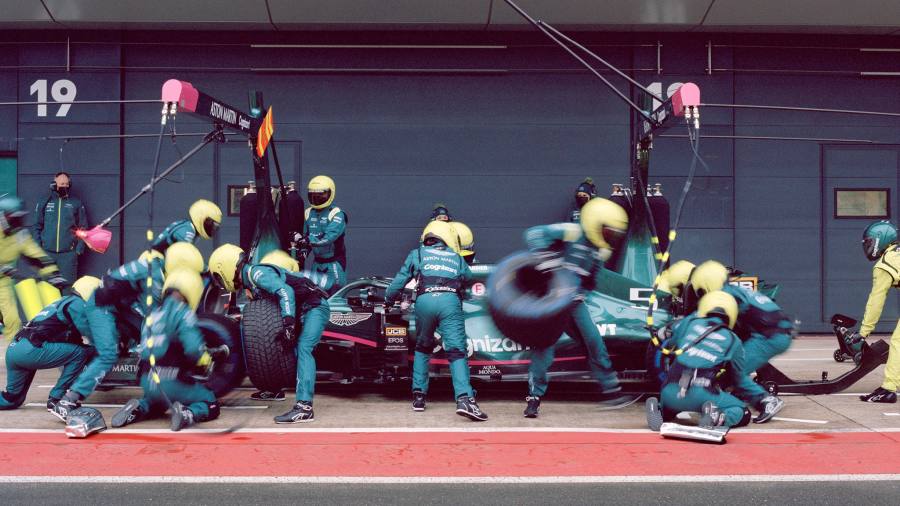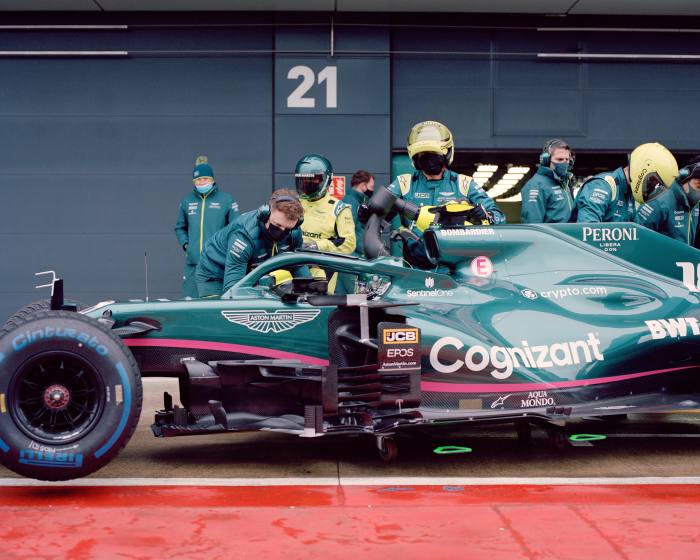
On a bitterly cold March morning at the Silverstone motor-racing circuit, a racket emanates from a hangar-sized garage. The noise — an engine revving, the zaps of a wheel-nut gun — reverberates enough to make your stomach tremble.
Inside, engineers in green overalls are making the final adjustments to a gleaming Formula One car. Four-time F1 world champion driver Sebastian Vettel jumps around trying to stay warm. Meanwhile, the team’s billionaire owner is beaming with pleasure at the scene.
“How good does this look?” bellows Lawrence Stroll, a tall Canadian in a bespoke grey pinstripe suit and blue overcoat.
Mostly, it looks like any F1 car preparing for the new season — with one crucial difference. The silver-winged badge on the vehicle’s nose signifies the return to the sport of one of the world’s most famous car marques: Aston Martin. And for those present the moment is infused with significance.
“It brought a tear to my eye,” Stroll says later, standing in the pit lane. He has just witnessed his son, one of the team’s drivers, screech out of the garage, leaving behind the smell of hot oil and rubber. It is the first time that an F1 car in the team’s British racing-green colours has turned its wheels since 1960. Another droplet gathers, then runs down Stroll’s cheek. He brushes it away with his thumb. “It’s one of the more emotional moments of my life. Sincerely.”
Lawrence Stroll is ploughing money into Aston Martin’s F1 team after leading a £500m takeover of the company © Cian Oba-Smith
Stroll, 61, made his fortune investing in luxury fashion brands but he has bet millions of dollars on Aston Martin’s return to the pinnacle of motorsport. Last year he led a consortium that completed a £500m takeover of Aston Martin Lagonda, the British maker of high-end cars that are the favourite of fictional superspy James Bond. Now Stroll has rebranded Racing Point, the F1 team he owns, under the Aston Martin name. The strategy is twofold: success on the track, which in turn will transform the fortunes of an ailing sports car brand.
As Aston Martin tested its new car at the empty circuit in Northamptonshire this month, the FT spent several days observing this plan in action, as well as speaking to the team’s executives, engineers, officials and drivers. Sunday’s opening race in Bahrain is the moment of truth for this high-risk gamble, one that wagers Stroll’s fortune, his reputation and the livelihoods of 3,000 people working under him on a fiendishly difficult task: producing a winning race car.
But it isn’t just the story of a rich man’s sporting dreams being realised. This is an important test for the global racing series too. In recent years, F1 has been dominated by Lewis Hamilton driving an all-conquering Mercedes, turning what was once an unmissable battle of speed and skill into a procession admired mostly by motoring purists. Can the sport make room for an ambitious challenger?
With a fortune valued at $3.2bn, Lawrence Stroll has collected the trappings of a tycoon: a private jet, a superyacht called Faith. Yet he says: “The most exciting moment of my life was when I turned 16 and got my driver’s licence. That’s a little different to today for kids with Uber.”
Stroll’s boyhood obsession with fast cars remains. He has spent millions of dollars building a collection of classic vehicles, including a Ferrari 250 GTO, widely considered the world’s most desirable car. There are only 36 in existence; fellow owners include fashion designer Ralph Lauren, Walmart retail scion Rob Walton and Pink Floyd drummer Nick Mason.
But lately Stroll has been selling vintage Ferraris and replacing them with old Aston Martins. It is, he says, a symbolic shift, representing “the last chapter of my business life”.
That journey has been a long one. The son of Québécois clothes merchants, Stroll was handed control of the Pierre Cardin brand in Canada at just 18 years of age. He later made his own way by turning little-known designers such as Michael Kors and Tommy Hilfiger into global luxury fashion labels.
Yet his ambition to transform Aston Martin “into the pre-eminent luxury automotive company in the world” could be his toughest challenge yet. Over its 107-year history, Aston Martin has gone bust seven times. When Stroll launched the company’s latest rescue last year, it was on the brink of yet another collapse. The reasons for its corporate failures are complex but boil down to a perennial problem: not enough people want to buy Aston Martin cars.

Strict regulations dictate how F1 vehicles are built, from the precise width of the tyres to the materials used in the chassis © Cian Oba-Smith
A senior motorsport executive (who declined to be named) says that while today’s American bitcoin millionaires and Chinese entrepreneurs might splash their cash on a Lamborghini, acquiring an Aston Martin is the preserve of “a bloke in their fifties who has made some money in the City [of London]”.
Stroll wants to change that. He has taken dramatic steps since acquiring the company, such as replacing almost all of its senior management while securing a further £300m in investment. “The business couldn’t have survived without that,” he says. The company’s future remains precarious though. “There’s hardly any room for a mis-step for this business,” said Luke Hickmore, investment director at Aberdeen Standard Investments, last year.
The company has sustained heavy losses through a policy of “destocking” — deliberately holding back new cars until unsold vehicles piling up in dealerships are cleared. “It’s luxury 101,” says Stroll. “You always manufacture one . . . less than the demand, in order to create a bit of a pent-up demand.” He has set the ambitious goal of selling 10,000 vehicles a year by 2025, up from about 4,000 last year. This means outselling rivals such as Rolls-Royce and Lamborghini. That is where motor racing comes in.
Last season, Stroll’s Racing Point team finished fourth out of 10 teams in F1’s constructors’ championship. Rebranding as Aston Martin is just the latest transformation in the outfit’s history stretching back more than 30 years; it has also raced under names such as Force India, Spyker Midland and Jordan.
Using F1 to sell stuff is hardly new. It is partly why Italian supercar maker Ferrari has competed for decades and why Red Bull, the Austrian energy drinks maker, funds a team. What is unclear is whether the marketing plan is effective. Other carmakers, including Lotus, Jaguar and BMW, gave up running F1 teams years ago, for reasons ranging from the struggle to remain competitive to sponsors pulling out.
Stroll’s confidence stems from a career talking up the value of objects until enough people want them. No stranger to hyperbole, the man who established a Ferrari dealership in Montreal now reckons Aston Martin produces “the most beautiful cars in the world”. Of his plan to use F1 to advertise them, he says: “It’s unbelievable, 100 million people, I believe, touch every Formula One race.” (F1 says its televised races worldwide last year had an average audience of 87 million.) Maths aside, what is certain is that the sport is watched by many people with at least a passing interest in supercars, if not the capability to acquire one.
“Some of those people will, either in the short term or in the long term, buy an Aston Martin,” says Jefferson Slack, Aston Martin F1’s commercial chief. “Our job is to make [the brand] younger, more dynamic, interesting, relevant, culturally relevant for lots of people.”

Aston Martin’s push into F1 may be well timed, with bigger teams set to reduce their spending in the coming seasons © Cian Oba-Smith
But the strategy also pushes Aston Martin in a different direction from its rivals. In October, Japanese carmaker Honda, which supplies engines to the Red Bull and Scuderia AlphaTauri teams, said it would pull out of F1 and focus on building zero-emissions technology instead.
Stroll points to a recent deal with Daimler to provide components to electrify Aston Martin roadcars. But the company’s fleet will probably switch to electric power more slowly than most of its luxury automotive rivals. While Stroll believes the majority of cars sold in future will be electric, at least some people will still want to buy cars that run on petrol or hybrid engines. Rather than going green at a faster clip, he hopes to overtake the opposition by exploiting the glamour of F1.
The plan has a snag: the need to win. After all, who will be convinced about spending £160,000 on one of Aston Martin’s new DBX sport utility vehicles or even £2.5m on its state-of-the-art Valkyrie hypercar, if his F1 team is stuck at the back of the grid?
“I couldn’t agree with you more,” says Stroll. “I did not do this — buy the business and invest so heavily to become executive chairman of Aston Martin — [to] tool around to be last.”
Formula One is a sport in which you must go to enormous lengths to make marginal gains. Take, for example, the 3.6-mile circuit at Silverstone. That is about the same distance as Hyde Park to Shepherd’s Bush in London. F1 cars cover the ground, including 18 corners, in comfortably less than a minute and a half.
Without the precise timekeeping provided by television coverage, the average person would barely notice the difference in speed between rival cars over a lap of the track. Strict regulations dictate how F1 vehicles are built, including hundreds of details, from the precise width of the tyres to the materials used in the chassis. That’s why rival cars look so similar and why they also run at relatively similar speeds.
But tiny advantages add up. At last year’s British Grand Prix at Silverstone, the winning Mercedes driven by Lewis Hamilton was a second a lap faster than 12th-placed George Russell in a Williams. Over 52 laps, those seconds accumulate to create an unbridgeable chasm. Hamilton, who has won seven F1 titles, is widely regarded as one of the best drivers of all time. But his finest feats have consistently come in the fastest car.

Aston Martin’s billionaire team owner saw something in Sebastian Vettel he didn’t possess: a driver who knows what it takes to win titles © Cian Oba-Smith
Since 2014, when regulations forced F1 teams to replace gas-guzzling internal combustion engines with hybrid ones, the sport has been dominated by three teams: Mercedes, Red Bull and Ferrari. Not coincidentally, they also have far larger budgets, spending hundred of millions of dollars more than their opponents. If money matters, what it buys is incremental. Engineers constantly seek ways to add speed and claw back tenths, even hundredths of a second. But the rules on car designs have resulted in an absurd arms race. One motorsport executive recalls a top team spending thousands of dollars just to shave less than a gramme from a wheel nut.
Meanwhile, smaller teams can only dream of putting their best engineering ideas into practice. “In the past, we used to develop the car and have ideas that would make the car go faster, but we never had the financial wherewithal to put them in place,” says Aston Martin team principal Otmar Szafnauer, who had the same role at Racing Point.

View from the cockpit: ‘Every lap, something changes,’ says Sebastian Vettel. ‘The tyres are different. The temperatures are different. The fuel load is different. The car behaves differently’ © Cian Oba-Smith
The result was that the big three kept coming out on top. Former F1 chief Bernie Ecclestone, who was ousted by its new US owner Liberty Media following a $8bn takeover in 2017, has said the predictable race outcomes left him “selling this shitty product and it embarrassed me”. Yet when asked more recently about Aston Martin’s chances of breaking into the elite, his response was positive: “[Stroll’s] not a loser.”
There is a sense that Aston Martin’s push into F1 may be well timed. Last year, tortuous negotiations led to an agreement on cost caps, limiting each team to spending no more than $145m in 2022, with reductions in subsequent seasons. Lower-placing teams will also be given fewer restrictions on how they can develop their cars. The hope is that the chasing pack will be capable of challenging the top constructors more often and creating a spectacle that attracts a new generation of fans.
The caps will initially exclude key items such as driver salaries and marketing costs. And, in a sport where cheating scandals occasionally emerge, critics contend that stricter limits will prove ineffective. “It’s more a matter of organisation and mentality for the big teams,” argues Stefano Domenicali, F1’s chief executive and a former team boss at Ferrari. “Don’t underestimate this effect. When you are used to having no limit . . . you have a structure that is delivering a lot of things without thinking in terms of being efficient.”
If so, the coming years provide a rare opening to Aston Martin, a route to overtaking dominant rivals. Stroll talks up those chances, particularly as the association with the motoring brand is bringing in greater sums from sponsorship deals. “We’re already spending at the budget cap right now,” he says enthusiastically. That may be the salesman talking, though. Szafnauer says it will be a couple of years before they reach the spending limits.

Rapid changes of direction when driving an F1 car generate G-forces so intense that most people would be unable to hold their heads up © Cian Oba-Smith
Aston Martin executives say third place in the constructors’ championship would be good progress towards competing for trophies. To that end, the team is working to improve those fine margins.
One is pit stops. During a race, each team has a crew of men and women who rapidly change the tyres and replace parts as quickly as possible. Andy Stevenson, Aston Martin’s sporting director, says the average stop lasts just 2.5 seconds. But small errors can push this up to 2.8 seconds. The loss of those three-tenths can be enough for the driver to fall back several places.
Stevenson says over recent months he has been given money to invest in specialist equipment and hire performance coaches to create individual training regimes for members of the pit crew to improve their “consistency” on race days. Weeks of effort, thousands of dollars spent, and all to gain less than half a second.
“Du bist Weltmeister!” These were the words Sebastian Vettel heard over his driver’s radio shortly after taking the chequered flag to win the 2010 Abu Dhabi Grand Prix. Then 23 years old, the German had just become the youngest world champion in F1 history. “Thank you, boys,” he told Red Bull teammates through tears.
Over the next three seasons, Vettel added three more F1 titles. But time can be cruel. Driving for Ferrari last year, he endured one of his worst ever seasons. He finished in a lowly 13th place in the overall driver standings; the team decided not to renew his contract.
But Lawrence Stroll spotted an opportunity. Ignoring recent form, the billionaire saw something he didn’t possess: a driver who knew what it took to win titles. So Stroll hired Vettel to join Aston Martin.

Sebastian Vettel, Aston Martin F1 driver: ‘There’s no silver bullet. Everybody’s looking for the one thing that gives you the advantage. The edge doesn’t exist. It’s being obsessed with details’ © Cian Oba-Smith
F1 world champions are rare creatures. They possess the ability to perform under tremendous physical strain. In particularly hot climates, such as Singapore, the temperature in the cockpit can reach up to 60C. Rapid changes of direction generate intense G-forces, the sort of pressure that would make most people unable to hold their heads up. This sensation forces up the heart rate to between 170 and 180 beats per minute, similar to that of a long-distance runner.
The average human would also panic when travelling at up to 230mph down a long straight with the next bend coming rapidly into view. F1 drivers treat those moments as respite, a chance to check in with their engineers over the radio.
Whereas in sports such as football or tennis, players are allowed breaks for rest, a Grand Prix feels like riding a rollercoaster for two hours straight. Each manoeuvre shaves or adds tenths or hundredths of a second. A mistake could mean a crash and the end of your race. As seen throughout F1’s history, a bad crash could mean the end of your life.
“Every lap, something changes,” says Vettel. “The tyres are different. The temperatures are different. The fuel load is different. The car behaves differently. To squeeze out the maximum every single time, that’s our job. That’s the key. But for that, you need to be bloody quick to react.”
Under these conditions, what makes Vettel remarkable is his clarity of thought, says Bernadette Collins, Aston Martin F1’s head of race strategy. A rare female leader in the sport, she decides on the team’s tactics, the best type of tyres for the weather conditions and how many times a car should stop during a race. As part of this planning, she spends hours gathering information on rivals by listening back to publicly available recordings of radio conversations between drivers and engineers.
“You listen to a lot of radio where drivers don’t know the plan,” she says. “They don’t know what’s happening around them. They don’t know the positions, or who’s pitted, or what’s happening [when] a safety car [comes out]. There are a few drivers that come along that when you listen, are clear, really clear. Really on top of things. Seb is one of those drivers.”

Bernadette Collins, Aston Martin F1 head of race strategy: ‘There are a few drivers that come along that when you listen, are clear, really clear. Really on top of things. Seb [Vettel] is one of those drivers’ © Cian Oba-Smith
Still, given the physical exertions of the sport, it would be natural for Vettel’s skills to decline over time. Szafnauer disagrees. “You don’t forget how to drive an F1 car quickly,” he insists. “We just have to listen to him, figure out exactly what he wants, give that to him and we’ll get the best out of him.”
So what went wrong at Ferrari for Vettel? He proffers only oblique criticisms of his former employer. “There’s a modern way to lead a company and there’s the oldish way,” he says. The implication is that last year’s failings were a team problem, that he wasn’t given a car in which he could succeed. If so, what does he need now? What will it take to win championships?
“There’s no silver bullet,” says Vettel. “Everybody’s looking for the one thing that gives you the advantage. The edge doesn’t exist. In my 15 years in F1, I haven’t found it . . . It’s really putting everything together. It’s being obsessed with details.”
This need for every detail to be perfect has raised question marks over Aston Martin’s other driver, Stroll’s 22-year-old son Lance. Though he is without a victory in F1 to date, Lance says he has grown a lot over the past few seasons but “there’s a lot of things that I can work on to be better. It’s so important to really stay very present in this sport, focus on the next corner, on the next lap, see how the future unfolds.”

Lance Stroll, Aston Martin F1 driver: ‘It’s so important to stay very present in this sport, focus on the next corner, on the next lap, see how the future unfolds’ © Cian Oba-Smith
His father points to a record as a highly regarded champion at youth levels, with creditable performances in F1 last season and a couple of podium finishes. Yet without parental munificence, it is unlikely the younger Stroll would be filling one of just 20 available driving spots in F1 — and not just because his dad runs a team. Toto Wolff, who leads the Mercedes F1 team, has said it costs $8m to manage a young driver, developing them from go-kart racing — overwhelmingly dominated by boys — up through higher tiers of motorsport before being considered capable of competing in an F1 car. It is the ultimate rich man’s game.
How have these calculations changed now that Aston Martin is inextricably linked to the F1 team’s success? What if Lance is far off Vettel’s pace? Lawrence Stroll considers the dilemma: “I don’t know too many fathers who could love their son as much as I love mine.” He shifts tack. “I think there’s millions of fathers like me. So don’t get me wrong. I don’t think it’s special, that I’m unique in that sense. Who would not want to do what’s best for their son?”
With the Aston Martins’ laps of Silverstone completed, the engineers spend hours stripping down the cars and packing up everything around them: helmets, toolboxes, computer stations. The following morning at 8am, this is all loaded on to an aeroplane and flown to Bahrain ahead of the first race.

F1 cars can cover the 3.6-mile circuit at Silverstone in less than a minute and a half © Cian Oba-Smith
Each vehicle is reassembled on arrival. Every part is cleaned again. Dozens of sensors are applied to the cars to recheck every component. Following these tests, more adjustments are made. After the drivers do test laps, they suggest further tweaks. The process will be repeated at the 22 other venues in the F1 travelling roadshow. It is the same for the other nine teams.
During testing in Bahrain, Red Bull’s Max Verstappen posted the fastest times, suggesting it would provide the stiffest opposition to Hamilton and Mercedes. Well off the pace last season, Ferrari wants to displace McLaren to regain a top-three position. Aston Martin’s cars appeared to run quickly but were unreliable, often breaking down. And there is little point building a fast car that can’t complete a race.
The opening Grand Prix will begin to answer important questions. Now under the Aston Martin banner, have the team’s cars got faster, or have they fallen behind? Vettel thinks it is impossible to know when they will be capable of being at the front of the grid. “Ultimately, it depends how serious you are about it and how committed you are in the long run,” he says.

An Aston Martin DBR5 at Silverstone Circuit in the final season of its earlier period in F1 © Bernard Cahier/Getty Images
Team executives insist that they are focused on racing, not how F1 results may affect the fate of the company. “Pressure can create diamonds or can burst pipes,” says Szafnauer. “You’ve got to really be careful as to what kind of pressure you put on.”
Sooner rather than later, however, Stroll needs victories to bolster his grand designs for the Aston Martin brand. Sporting results are more definitive than in the fashion business. Constructors and drivers are ranked. High finishes will win more points and trophies. Saying the cars have value will not make it so; Aston Martin will have to prove its worth on the track.
“Every business I’ve been in in my life, I’ve been fortunate enough to be extremely successful,” says Stroll. “We are coming back to Formula One to win.”
Murad Ahmed is the FT’s sports editor. Samuel Agini is the FT’s sports business reporter
This story has been amended since publication to say Aston Martin’s last F1 race was in 1960. The current cars can reach speeds of up to 230mph. Also a reference to refuelling at pit stops, which is no longer allowed, has been removed
Follow @FTMag on Twitter to find out about our latest stories first.
The post Aston Martin bets on a Formula One comeback to revive the brand first appeared on monter-une-startup.





